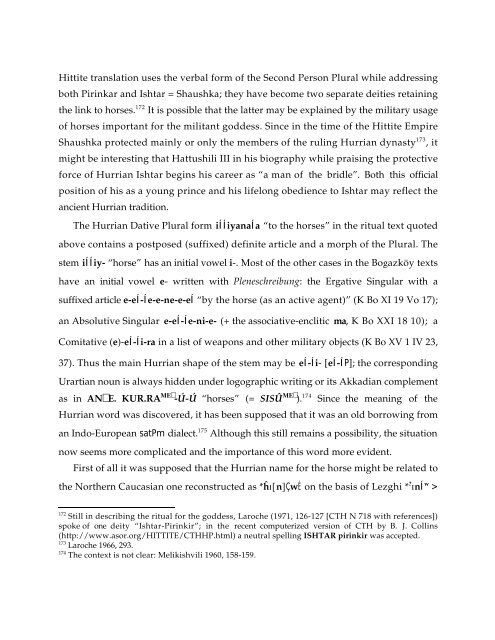Comparative Notes on Hurro-Urartian, Northern Caucasian
Comparative Notes on Hurro-Urartian, Northern Caucasian
Comparative Notes on Hurro-Urartian, Northern Caucasian
Create successful ePaper yourself
Turn your PDF publications into a flip-book with our unique Google optimized e-Paper software.
Hittite translati<strong>on</strong> uses the verbal form of the Sec<strong>on</strong>d Pers<strong>on</strong> Plural while addressing<br />
both Pirinkar and Ishtar = Shaushka; they have become two separate deities retaining<br />
the link to horses. 172 It is possible that the latter may be explained by the military usage<br />
of horses important for the militant goddess. Since in the time of the Hittite Empire<br />
Shaushka protected mainly or <strong>on</strong>ly the members of the ruling Hurrian dynasty 173 , it<br />
might be interesting that Hattushili III in his biography while praising the protective<br />
force of Hurrian Ishtar begins his career as “a man of the bridle”. Both this official<br />
positi<strong>on</strong> of his as a young prince and his lifel<strong>on</strong>g obedience to Ishtar may reflect the<br />
ancient Hurrian traditi<strong>on</strong>.<br />
The Hurrian Dative Plural form iÍÍiyanaÍa “to the horses” in the ritual text quoted<br />
above c<strong>on</strong>tains a postposed (suffixed) definite article and a morph of the Plural. The<br />
stem iÍÍiy- “horse” has an initial vowel i-. Most of the other cases in the Bo azköy texts<br />
have an initial vowel e- written with Pleneschreibung: the Ergative Singular with a<br />
suffixed article e-eÍ-Íe-e-ne-e-eÍ “by the horse (as an active agent)” (K Bo XI 19 Vo 17);<br />
an Absolutive Singular e-eÍ-Íe-ni-e- (+ the associative-enclitic ma, K Bo XXI 18 10); a<br />
Comitative (e)-eÍ-Íi-ra in a list of weap<strong>on</strong>s and other military objects (K Bo XV 1 IV 23,<br />
37). Thus the main Hurrian shape of the stem may be eÍ-Íi- [eÍ-ÍP]; the corresp<strong>on</strong>ding<br />
<strong>Urartian</strong> noun is always hidden under logographic writing or its Akkadian complement<br />
as in AN E. KUR.RA -Ú-Ú “horses” (= SISÛ ). 174 Since the meaning of the<br />
Hurrian word was discovered, it has been supposed that it was an old borrowing from<br />
an Indo-European satPm dialect. 175 Although this still remains a possibility, the situati<strong>on</strong><br />
now seems more complicated and the importance of this word more evident.<br />
First of all it was supposed that the Hurrian name for the horse might be related to<br />
the <strong>Northern</strong> <strong>Caucasian</strong> <strong>on</strong>e rec<strong>on</strong>structed as *hÈI[n]ÇwÈ <strong>on</strong> the basis of Lezghi * ? InÍ w ><br />
172 Still in describing the ritual for the goddess, Laroche (1971, 126-127 [CTH N 718 with references])<br />
spoke of <strong>on</strong>e deity “Ishtar-Pirinkir”; in the recent computerized versi<strong>on</strong> of CTH by B. J. Collins<br />
(http://www.asor.org/HITTITE/CTHHP.html) a neutral spelling ISHTAR pirinkir was accepted.<br />
173 Laroche 1966, 293.<br />
174 The c<strong>on</strong>text is not clear: Melikishvili 1960, 158-159.





